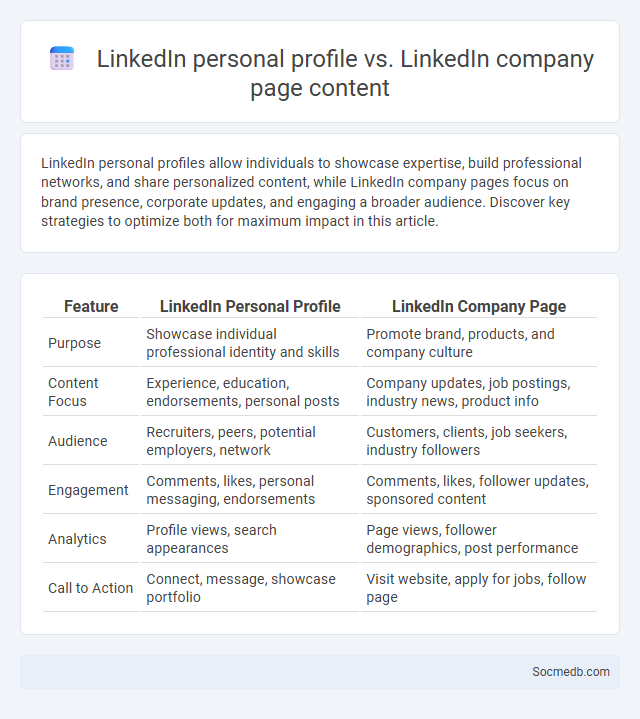
Photo illustration: LinkedIn personal profile vs LinkedIn company page content
LinkedIn personal profiles allow individuals to showcase expertise, build professional networks, and share personalized content, while LinkedIn company pages focus on brand presence, corporate updates, and engaging a broader audience. Discover key strategies to optimize both for maximum impact in this article.
Table of Comparison
| Feature | LinkedIn Personal Profile | LinkedIn Company Page |
|---|---|---|
| Purpose | Showcase individual professional identity and skills | Promote brand, products, and company culture |
| Content Focus | Experience, education, endorsements, personal posts | Company updates, job postings, industry news, product info |
| Audience | Recruiters, peers, potential employers, network | Customers, clients, job seekers, industry followers |
| Engagement | Comments, likes, personal messaging, endorsements | Comments, likes, follower updates, sponsored content |
| Analytics | Profile views, search appearances | Page views, follower demographics, post performance |
| Call to Action | Connect, message, showcase portfolio | Visit website, apply for jobs, follow page |
Introduction to LinkedIn Personal Profiles and Company Pages
LinkedIn personal profiles showcase your professional experience, skills, and recommendations, serving as your digital resume to attract recruiters and networking opportunities. Company pages highlight your brand's mission, products, and career opportunities, boosting visibility among industry professionals and potential clients. Optimizing both profiles and pages enhances your social media strategy, positioning you and your business as credible and influential within your industry.
Key Differences: Personal Profile vs Company Page
Personal profiles are designed for individual use, allowing you to connect with friends and share personal updates, while company pages serve as a professional platform to promote your business, engage customers, and showcase products or services. Your company page provides analytics, advertising options, and branding tools unavailable on personal profiles, enabling targeted marketing and performance tracking. Optimizing your social media strategy requires understanding these differences to effectively build your brand presence and reach your audience.
Importance of Content Strategy on LinkedIn
A well-crafted content strategy on LinkedIn boosts your professional visibility by targeting the right audience with relevant posts, enhancing engagement and networking opportunities. Consistent, value-driven content establishes your authority in your industry, attracting potential clients, partners, and recruiters. Your strategic approach on LinkedIn transforms connections into meaningful relationships, driving career growth and business success.
Personal Branding Content for LinkedIn Profiles
Creating personal branding content for LinkedIn profiles involves strategically showcasing your professional skills, achievements, and unique value proposition to attract potential employers or clients. Optimizing your LinkedIn headline, summary, and experience sections with relevant keywords enhances your profile's visibility in search results. Your content should demonstrate industry expertise, thought leadership, and consistently reflect your personal brand to build credibility and professional network growth.
Corporate Messaging for Company Pages
Corporate messaging on company social media pages plays a crucial role in shaping brand identity and engaging stakeholders effectively. Your posts should emphasize clear, consistent messaging that reflects company values, mission, and culture while encouraging authentic interaction with your audience. Incorporating targeted keywords and timely updates enhances visibility and reinforces your company's position within the industry.
Types of Content Best Suited for Personal Profiles
Personal profiles on social media thrive with a mix of authentic photos, engaging stories, and relatable video content that highlights your personality and interests. Sharing behind-the-scenes moments, personal achievements, and day-to-day experiences helps build genuine connections with your audience. Interactive content like polls, Q&A sessions, and live videos encourages meaningful engagement, making your profile more dynamic and approachable.
Content Formats Effective for Company Pages
Video content generates 1200% more shares than text and images combined, making it essential for maximizing engagement on company social media pages. Infographics enhance information retention by up to 80%, effectively communicating complex data in a visually appealing format. Polls and interactive content boost user interaction rates by over 70%, fostering community involvement and driving higher organic reach.
Audience Targeting: Individuals vs Organizations
Audience targeting on social media differs significantly between individuals and organizations, with organizations leveraging advanced analytics and demographic data to tailor campaigns for specific market segments. Individuals often rely on personal networks and interests for content sharing and engagement, while organizations utilize tools like Facebook Ads Manager and LinkedIn Campaign Manager to target potential customers based on behavior, location, and preferences. Your social media strategy benefits from understanding these distinctions to optimize engagement and reach effectively.
Measuring Success: Analytics and Engagement
Measuring success on social media relies heavily on analytics tools that track key performance indicators like reach, engagement rate, and conversion metrics. Platforms such as Facebook Insights, Instagram Analytics, and Twitter Analytics provide detailed data on user interactions, content performance, and audience demographics. High engagement rates, including likes, shares, comments, and click-through rates, serve as strong indicators of effective social media strategies driving brand visibility and customer loyalty.
Integrating Both Profiles into a Unified LinkedIn Content Strategy
Integrating both personal and professional profiles into a unified LinkedIn content strategy enhances brand consistency and maximizes audience engagement. Posting a balanced mix of industry insights, personal achievements, and company updates leverages LinkedIn's algorithm to boost visibility and credibility. Optimizing profile keywords and regularly engaging with networks increases connection growth and thought leadership opportunities.
 socmedb.com
socmedb.com